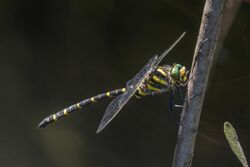Biology:Golden-ringed dragonfly
| Golden-ringed dragonfly | |
|---|---|

| |
| Male in Fermyn Woods, Northamptonshire, UK | |

| |
| Female in Arne, Dorset, UK | |
| Scientific classification | |
| Domain: | Eukaryota |
| Kingdom: | Animalia |
| Phylum: | Arthropoda |
| Class: | Insecta |
| Order: | Odonata |
| Infraorder: | Anisoptera |
| Family: | Cordulegastridae |
| Genus: | Cordulegaster |
| Species: | C. boltonii
|
| Binomial name | |
| Cordulegaster boltonii (Donovan, 1807)
| |
| Synonyms | |
| |
The golden-ringed dragonfly (Cordulegaster boltonii) is a large, striking species of dragonfly found widely in Europe and locally in northwestern Africa, especially near flowing waters like streams.[1] It is the longest British species of dragonfly,[2] and the only member of its genus to be found in the United Kingdom.[3]
Identification
In the United Kingdom, they are easily identified by their distinctive black and yellow stripes, which is not found in any other dragonfly in the country.[4] A very large species, males average 74 mm (2.9 in) and the longer females average 84 mm (3.3 in). Wingspan is up to 101 mm (4.0 in).[5] The female is the longest British dragonfly, in part due to the unusually long ovipositor,[2] and in other measurements it is exceeded by the emperor (Anax imperator).[6]
Larvae
The female lays the eggs in shallow water. The hairy larvae live at the bottom of the water and are well camouflaged amongst the silt.[7] They emerge after about 2–5 years, and usually under the cover of darkness.
Behaviour
They are often seen flying leisurely over mountain streams or a river; they also occasionally show up at a pond. They are also typically seen flying over heath land. Their bright yellow and black stripes make them easy to identify, even from a fair distance away. They feed mainly on insects ranging from small prey such as midges to flies, butterflies and even bumblebees. This strikingly-coloured insect is incredibly aerobatic and they sometimes fly very high up into the sky.[8]
See also
- List of British dragonflies
References
- ↑ 1.0 1.1 Paulson, D.R. (2020). "Cordulegaster boltonii". IUCN Red List of Threatened Species 2020: e.T165509A140511553. doi:10.2305/IUCN.UK.2020-3.RLTS.T165509A140511553.en. https://www.iucnredlist.org/species/165509/140511553. Retrieved 11 November 2021.
- ↑ 2.0 2.1 "Cordulegaster boltonii". British Dragonfly Society. http://british-dragonflies.org.uk/species/golden-ringed-dragonfly.
- ↑ "Golden-ringed dragonfly (Cordulegaster boltonii)". ARKive. http://www.arkive.org/species/ARK/invertebrates_terrestrial_and_freshwater/Cordulegaster_boltonii/.
- ↑ "UK Safari". http://www.uksafari.com/goldenring.htm.
- ↑ "Golden-ringed dragonfly videos, photos and facts - Cordulegaster boltonii - ARKive". http://www.arkive.org/golden-ringed-dragonfly/cordulegaster-boltonii/.
- ↑ "Emperor". British Dragonfly Society. http://british-dragonflies.org.uk/species/emperor-dragonfly.
- ↑ "Wild Scotland". Archived from the original on October 6, 2008. https://web.archive.org/web/20081006105043/http://www.wild-scotland.co.uk/dragonflies.aspx.
- ↑ "Dragonflies at Plas Farm". http://www.welshholidaycottages.com/countryside/dragonfly-species.htm.
External links
Wikidata ☰ Q232843 entry
 |


